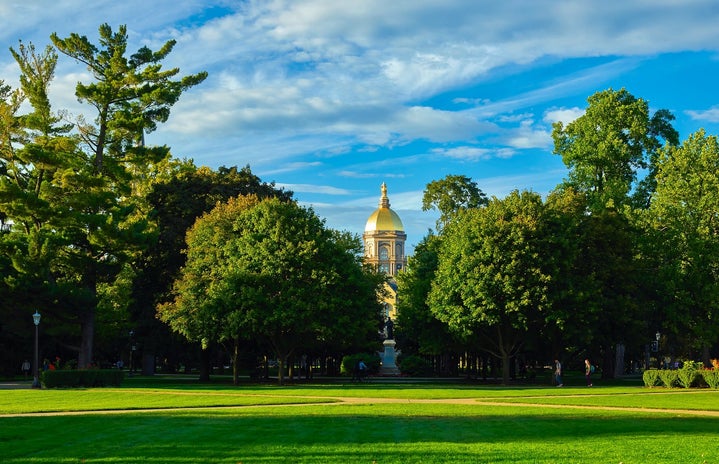Disclaimer: This article discusses sexual harassment and assault.
Imagine for a moment that you’re standing on the bank of a river with your friend. The sun is warm, and you can feel beads of sweat forming on your brow as you watch the water rush past you. Suddenly, around the bend you see something bobbing up and down. But you can see something else. As you squint through the sun, you see splashing around the object. “Holy shit,” you think to yourself, “that’s a person!” You grab your friend and run into the river. You successfully pull the person out of a river and save them from drowning. When you look up, you see another person rushing toward you, floundering in the water. You dart right back in, and save them too. Then a third person comes around the corner, floundering in the water. “What the hell, three people drowning? Something must be going on.” You turn around and start running up the river. Where are all these people coming from? “Where the hell are you going?!” Your friend shouts. “I have to see what’s going on,” you shout back, “there’s no way this is a coincidence!” Three people can’t spontaneously drown in the river at the same time. Something must be going on upstream.
The problem with sexual assault in the workplace is way upstream. It doesn’t start when men are already in positions of power. The Harvey Weinstiens and Donald Trumps of the world develop their patterns of abuse long before they become executives. Around 2015 or 2014, there was an outpouring of stories about sexual assault on college campuses across the United States. Many people believed that this was the root of the problem: the bad behavior that we see in the workplace starts with bad behavior at college parties. But this idea always seemed insane to me. The revelations about assault on college campuses were nothing new to me. Even though I was no older than 16 or 17, I wasn’t shocked at all. Most of that behavior was already happening at my high school. And it didn’t start there. It is time that we treat assault and harassment as the public health crisis that it is, mobilize resources to stop it at the root.
So let’s define some terms, shall we?
At Kenyon, my college, sexual harassment is defined as:
“any unwelcome sexual advance, request for sexual favors, or other unwanted verbal or physical conduct of a sexual nature when one or more of the following conditions are present: Submission to or rejection of such conduct is an explicit or implicit condition of an individual’s employment, evaluation of academic work, or any aspect of a College program or activity; or Submission to or rejection of such conduct by an individual is used as the basis for decisions affecting the individual; or Such conduct has the purpose or effect of unreasonably interfering with an individual’s work or academic performance, i.e. it is sufficiently serious, pervasive, or persistent as to create an intimidating, hostile, demeaning, or sexually offensive working, academic, residential, or social environment under both an objective and subjective standard.”
Most definitions are pretty similar across college campuses and in the workplace. The United States Justice Department defines sexual assault as: “Sexual assault is any type of sexual contact or behavior that occurs without the explicit consent of the recipient. Falling under the definition of sexual assault are sexual activities as forced sexual intercourse, forcible sodomy, child molestation, incest, fondling, and attempted rape.” Yet, there remains a tremendous amount of confusion over what does and does not count as sexual harassment. In reality, it’s really quite simple:
The Disconnect Between Law and Society
Apparently this is not as self-explanatory as Claire from HR would have hoped. But why is that? There is a general lack of understanding of how to treat people in sexual or intimate relationships in the United States. Whether we like it or not, schools are teaching our kids how to live. As humans move throughout the world, they are constantly socialized; by their friends, their parents, their teachers, by television shows, commercials, and movies. When such bad behavior is so widespread, there is clearly a disconnect between our laws and the values and behavior we are teaching in our schools. In a select few number of high schools across the country, educators and administrators have begun to attempt to teach students how to prevent sexual assault, and what kinds of behavior counts as sexual assault and harassment. You can expect if you attend any major college or university to have some type of training on assault and harassment during your orientation.
But schools across Scandinavia are attempting to combat sexual assault and harassment in a different way. They teach young people how to have healthy relationships and open, honest conversations about sex. Norway’s government launched a series of educational videos to teach children about what happens to their bodies as they go through puberty. And the conversations aren’t just about sex, they’re about how to have healthy relationships. In Scandinavia, kindergarteners are asked if they have ever been in love during. Sexuality education begins there when kids are 4 years old. Each age group is taught age-appropriate information about healthy relationships, which eventually includes sex education. As a result of these policies, Scandinavian countries have seen a decrease in negative health markers like child pregnancy rates, HIV contraction rates, and sexual assault rates. Scandinavian teens use contraceptives at a higher rate than teens in the U.S. and have significantly higher health outcomes.
Right now, in the United States, policymakers are standing on the bank of the river, watching people drown. Slowly, more and more people have waded into the water, to try to drag folks to safety. The increase in reporting of assault and harassment both in the workplace and in places of higher education is valuable, it’s like pulling people floundering in the river to safety. But still more people come around that bend. Other countries, like Norway and Sweden, are standing on the opposite bank, seeing the same people come around the bend. They already went upstream to find the root of the problem. Americans have successfully done this in the past. Since the 1980s, we’ve seen a dramatic reduction in deaths from drunk drivers because a group of mothers got together and said enough is enough. Everyone has seen public service announcements about drunk driving and the risks involved. Since this advocacy began, deaths from drunk driving accidents have fallen by 50 percent. We have worked to resocialized our citizens to prevent people from drinking and driving, so why don’t we resocialize them to prevent sexual assault and harassment from happening in the first place? There will always be outliers, someone who does the wrong thing despite all the education. But that doesn’t mean we shouldn’t try.
Image Credit: Feature, 1, 2, 3


